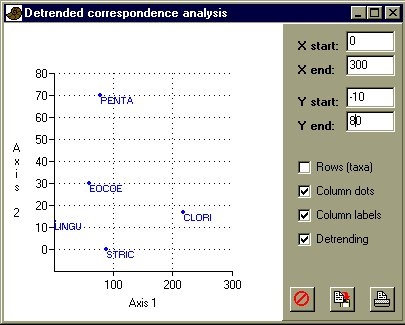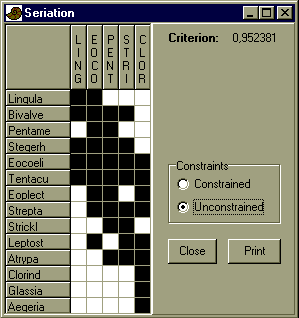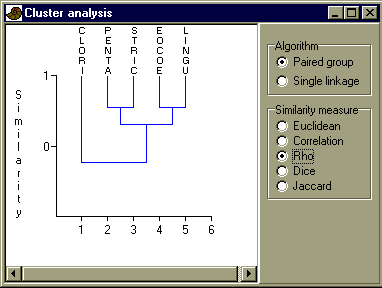
| Case study 9 - Lower Silurian marine communities from Britain |
Data file: llandov.dat
A consistent pattern of faunal changes through increasing water depth has been reported from many Llandovery (lower Silurian) successions throughout the world. Five communities are sequentially developed: the Lingula, Eocoelia, Pentamerus, Stricklandia and Clorinda communities occupied depth bands from intertidal environments to at least the edge of the continental shelf. These communities or ecogroups have proved useful in defining a sequence of depth zones or Benthic Assemblage Zones (BA) with increasing depth from BA1 to BA6. The geographic distribution of these communities in the Anglo Welsh area is illustrated below (modified from Clarkson 1993, fig. 7.18):

Data abstracted from Cocks & McKerrow (1984)
are available in llandov.dat. The presence or
absence of fourteen key taxa across the five depth-related communities,
Lingula, Eocoelia, Pentamerus, Stricklandia and Clorinda
is recorded. The following taxa were included in the analysis together
with their approximate community assignments:
Lingula community: Lingula, bivalves (all),
Stegerhynchus.
Eocoelia community:: Eocoelia, Tentaculites, Leptostrophia.
Pentamerus community:: Pentamerus or Pentameroides,
streptelasmid corals, Atrypa or Protatrypa.
Stricklandia community: Stricklandia or
Costistricklandia.
Clorinda community: Clorinda, Coolinia, Glassia, Eoplectodonta
and Aegiria.

Discuss the mutual differences and similarities between each pair of associations. Which pairs of communities are most similar and are there any recognisable trends? Also try the Raup-Crick measure, and compare with Jaccard and Dice.
More information about Jaccard, Dice and Raup-Crick coefficients can be found in the manual.

More information about the clustering module can be found in the manual.

The program has ordered the associations along two ordination axes. What is the order of associations along the principal axis (Axis 1)? Is this in correspondence with the environmental gradient?
More information about the detrended correspondence analysis module can be found in the manual.

More information about the seriation module can be found in the manual.
